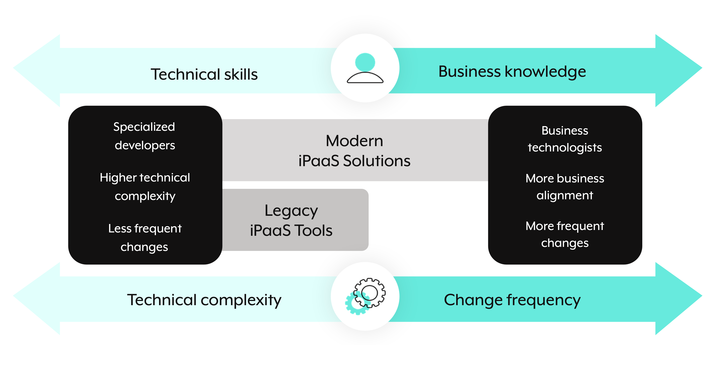In contemporary business environments characterized by rapid change and competition, seamless integration, automation, and continuous innovation across diverse tools and operational processes have transitioned from being a strategic advantage to an indispensable requirement for success.
This is where an Integration Platform as a Service (iPaaS) steps in when your business’s growth increases the complexity of your workflows. Think of an iPaaS as the glue that binds your apps, data, and systems while ensuring they collaborate harmoniously to drive efficiency and innovation.
But with over 150 vendors crowding the market, how do you choose the right iPaaS for your organization? To help you answer this question, look no further than our iPaaS Buying Kit—which includes a comprehensive iPaaS Buying Guide and accompanying Request For Proposal (RFP) Template—to help you cut through the noise and make a confident and informed decision.
Today, companies use a wide range of tools and workflows, leading to fragmented processes, siloed data, and unmanageable complexity. Companies have tried to solve this for decades by creating a connected enterprise through custom code and legacy middleware solutions. These methods worked for a time, but eventually, they evolved into projects suffering from high maintenance costs and slow time to value, resulting in resource bottlenecks and missed opportunities for innovation.
The modern iPaaS platform shines in this regard; unlike outdated middleware, a true cloud-native iPaaS enables seamless integration across your enterprise’s systems, applications, and data. Silos are broken and workflows are streamlined. Organizations can respond to market demands and innovate at breakneck speeds by reducing integration and infrastructure bottlenecks.
However, iPaaS is not resting on its laurels as it evolves at the speed of technology. With disruptive technologies such as generative AI, large language models, and AI copilots, today’s platforms harness them to design and optimize workflows. These advancements democratize the space and make integration accessible to business users, eliminating reliance on specialized resources and delivering huge time and cost savings, as seen in the diagram below.
Adopting a forward-thinking iPaaS strategy can begin to lay the foundation for a fully connected, agile enterprise. Greet the tools of the future with open arms and unlock the incredible potential of orchestration to thrive today and tomorrow.
By adopting a forward-thinking iPaaS strategy, your business can lay the foundation for a fully connected, agile enterprise. Embrace the tools of the future and unlock the potential of seamless integration to stay ahead in today’s competitive landscape.
Why Download the Kit?
This isn’t just any other whitepaper; it’s a detailed roadmap to orchestration success. Within the guide, you’ll find:
- Operating Models Explained: Learn the pros and cons of different operating model approaches to choose the one that best fits your organization.
- Core Features to Look For: Understand which functionalities, like API management, data orchestration, AI-powered orchestration, and cloud-native architecture, are non-negotiable for a future-ready iPaaS.
- Stakeholder Benefits: Discover how IT, data, and business teams can all thrive with the right iPaaS in place.
- Key Evaluation Criteria: Find a detailed and downloadable RFP template to evaluate different offerings in your buying journey. Also included is a list of technical and business questions that will help you assess each vendor’s ability to support you in your short and long-term goals.
Get Started Today
If your business is ready to scale, adapt, and innovate the right iPaaS partnership can be a game-changer. Don’t miss out—take the guesswork out of your decision-making process and download our iPaaS Buying Kit today.

